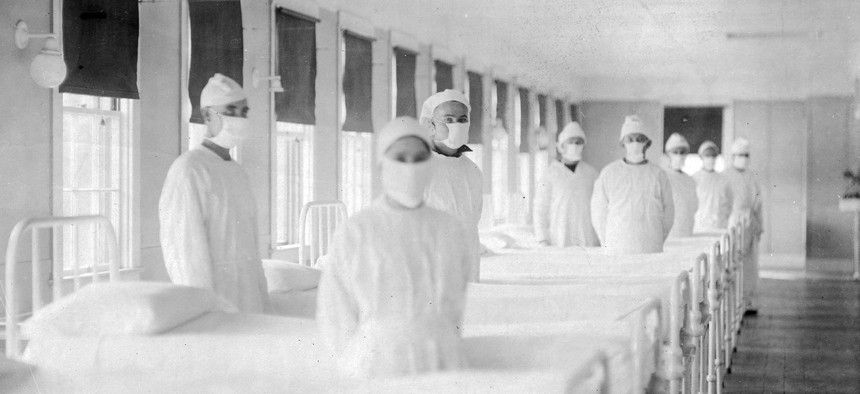In an ideal outbreak scenario, at the first signs of illness—or even after a concerning exposure—everyone would go get a quick test. It could assure them that they’re okay to go to work, or to go to a public gathering, or even to go home. If a test were positive, that person’s close contacts would be alerted of an anonymous exposure. They would be advised to come get tested. The process would be fast, easy, ubiquitous, and free.
Given the nature and spread of this particular virus, though, this textbook public-health approach to tracking and containment has proven infeasible. Even if perfect tests were widely available, and everyone agreed to get tested as soon as possible whenever they felt sick, demand for screening and evaluation would overload existing doctors’ offices and hospitals.
Emergency funds could theoretically be used to set up makeshift screening clinics in parking lots and public spaces. After being screened, some people could be escorted to a hospital for further treatment and evaluation. Others could be reassured that they were clear and go back to work. Still others could be advised to self-isolate at home until the illness passes, and to call, text, or return if symptoms escalated.
The best possible monitoring and communication will nonetheless prove vital to determining who needs hospital beds in the midst of a rapidly spreading, temperamental disease. Without it, to simply tell people to “stay at home if you’re sick” will be inadequate. Most cases of COVID-19 are reportedly “mild,” but that term can be misleading. As the World Health Organization adviser Bruce Aylward clarified last week, a “mild” case of COVID-19 is not equivalent to a mild cold. Expect it to be much worse: fever and coughing, sometimes pneumonia—anything short of requiring oxygen. “Severe” cases require supplemental oxygen, sometimes via a breathing tube and a ventilator. “Critical” cases involve “respiratory failure or multi-organ failure.”
The disease can sometimes escalate unexpectedly, and even healthy young patients will need people checking in on them. They may be fine at home initially, but would need to know precisely what to watch out for, and when to seek care. People who do require medical supervision—but not hospital care—need a place to go and stay. This could include people with escalating symptoms or underlying risk factors. Even patients with a mild case will need places to self-isolate if they live with others who have not yet been infected, especially if those people are older or immune-compromised.
China addressed this issue by mandating that sick people in Wuhan go into quarantine for two weeks, at one of the dozens of hastily adapted or constructed emergency facilities that look almost like military field hospitals. People are given food, beds, and medical monitoring. They can socialize with other sick people, and they can be transferred to a hospital if that becomes necessary.
In the U.S. and most other countries, the process of removing oneself from society for two weeks is not so straightforward—or even possible, for many people. The Centers for Disease Control and Prevention has ordered some mandatory two-week quarantines, but so far only for a few hundred travelers. The contained have passed their days at military bases, of which the country has 15 with designated space for quarantines. The capacity for housing and feeding larger numbers of people is nowhere near what may be needed. In February the Pentagon “ramped up ” the military bases in preparation to quarantine 1,000 people.
Though mandatory quarantining at large scales would be infeasible (and legally treacherous), governments might at least offer facilities for people who have nowhere else to go when they get sick. To that end, Washington State’s public-health officials have already procured an Econolodge. Others could anticipate similar needs and secure local hotels, or retro-fit empty stadiums or dead malls, or even cruise ships at port. Ideally the accommodations would be nicer than military bases and would not feel punitive—or else people will not use them.
Given the expanding global recommendations to avoid large gatherings and limit travel, such arrangements might also keep the hospitality industry from collapsing.
If all of this were happening, the United States might be able to avoid the sort of widespread shutdowns of cities, businesses, and institutions that are playing out in Italy, China, and elsewhere. But it is not happening. People who are sick are told only to go home. A shortage of tests means that many people are staying home who do not need to. Many others are going out because they can’t afford to stay home and miss work. Many don’t have health insurance, or fear the costs of being hospitalized. There is a strong financial incentive to conceal symptoms, to try to keep working and caring for children, and by consequence spreading the virus.
Health officials are then faced with a challenge. What to do with this person, sick and alone in their car, and not allowed into their own doctor’s office? This is where a test for the coronavirus would be of use. Until this week, though, the state of Connecticut had received only one coronavirus testing kit from the CDC. Testing capacity is increasing now, in partnership with private labs. But as of Monday afternoon, an ongoing Atlantic investigation could only confirm that 4,384 tests had been conducted nationally.
This number is projected to increase quickly, but not instantly. Anthony Fauci, the director of the National Institute of Allergy and Infectious Diseases, said in an interview with JAMA
Expectations are tempered; a similar promise from Vice President Mike Pence of 1.5 million tests by the end of last week did not come to pass. But even when these tests eventually are available, some limitations will have to be realized. Among them, these are diagnostic
The difference comes down to a metric known as sensitivity of the test: how many people who have the virus will indeed test positive. No medical test is perfect. Some are too sensitive, meaning that the result may say you’re infected when you’re actually not. Others aren’t sensitive enough, meaning they don’t detect something that is actually there.
The latter is the model for a diagnostic test. These tests can help to confirm that a sick person has the virus; but they can’t always tell you that a person does not. When people come into a clinic or hospital with severe flu-like symptoms, a positive test for the new coronavirus can seal the diagnosis. Screening mildly ill people for the presence of the virus is, however, a different challenge.
“The problem in a scenario like this is false negatives,” says Albert Ko, the chair of epidemiology of microbial diseases at the Yale School of Public Health. If you wanted to use a test to, for example, help you decide whether an elementary-school teacher can go back to work without infecting his whole class, you really need a test that will almost never miss the virus.
“The sensitivity can be less than 100 percent and still be very useful,” Ko says, in many cases. But as that number falls, so does the usefulness of any given result. In China, the sensitivity of tests has been reported to be as low as 30 to 60 percent —meaning roughly half of the people who actually had the virus had negative test results. Using repeated testing was found to increase the sensitivity to 71 percent . But that means a negative test still couldn’t fully reassure someone like the teacher that he definitely doesn’t have the virus. At that level of sensitivity, Ko says, “if you’re especially risk-averse, do you just say: ‘If you have a cold, stay home’?”
“An inaccurate test—one prone to false positive or false negative results, can be worse than no test at all,” Ian Lipkin, an epidemiology professor at Columbia University, told me in an email. The CDC has not shared the exact sensitivity of the testing process it has been using. When Fauci was asked about it on Monday, he once again hedged. “If it’s positive, you absolutely can make a decision,” he said. If it’s not, that’s a judgment call. Usually a second test is recommended, and it depends on the patient’s symptoms, exposures, and how sick they appear to be.
The tests involve other variables, too. Samples must be taken using a long cotton swab that goes into the back of the patient’s nose (or mouth, though this seems to be a less sensitive method). In either case, sometimes you just don’t get enough mucus on the swab. It can be hard to know if that was the cause of a negative test result when results come in from the lab a day later.
In attempt to increase sensitivity of the testing process, China not only swabbed people multiple times, but also added CT scans for an additional clue. The scans can sometimes help identify the unique patterns of lung damage caused by the virus, says Howard Forman, who practices radiology in the emergency department at Yale–New Haven Hospital. But scanning is a slow process to do at large scales, and it’s costly and involves exposure to radiation. “You would need dedicated scanners as well, so as not to contaminate other patients,” he told me. “So it becomes very difficult to use CT for high-level screening.”
Given the number of variables, widespread screening test for the virus are not looming on the horizon as a way to obviate the urgent need for social distancing .
Some hope is being placed in biotech companies that are working to develop quick, mobile tests that could give results anywhere—be it at a doctor’s office or in a modified parking lot. “The goal would be to allow people to know if they have a cold or if they have the virus and need to self-quarantine, right there in the doctor’s office,” says William Brody, a radiologist and former president of Johns Hopkins University. He is currently working one such project with Hong Cai, a molecular biologist, at a small company called Mesa. The duo told me this is, at best, months away from being tested widely. Even then, its sensitivity will remain to be seen, and will likely be less than that of the current, slower tests. But she says her team is working as expeditiously as possible to solve the problem.
In the absence of a quick, sensitive, ubiquitous screening test that can decisively rule out coronavirus infection—and send healthy people back out into the world to work and to live— we face unique challenges. The World Health Organization is lately signaling that a declaration of pandemic is imminent. Leaders point to dramatic shutdown and mass quarantine measures taken in China in laudatory terms—as evidence that lives can be saved, and this is how. Other countries are already following China’s example. Italy has banned weddings and funerals as the number of cases exploded in recent days. Japan has closed schools for a month. France has banned large public gatherings, and Iraq has banned even small ones. The United Nations has canceled all in-person meetings to address climate change.
For now at least, it seems, minimizing damage will involve sweeping and imprecise action. To shut down a city, or a country, is to gamble that incurring disastrous economic consequences in the short term will prevent even more disastrous consequences in the longer term. In the nightmare scenario that everyone is trying to avoid, the disease spreads so quickly that a country’s health-care system is overwhelmed, and people go untreated amid panic and chaos.
A pandemic is like a slow-motion hurricane that will hit the entire world. If the same amount of rain and wind is to hit us in any scenario, better to have it come over the course of a day than an hour. People will suffer either way, but spreading the damage out will allow as many people as possible to care for one another.
Slowing the disease requires asking people to isolate themselves and, in most cases, stop working. Most of the world cannot shelter in place for long without income. When people are asked to survive alone—without the cultural, social, and financial inputs that typically keep us alive—new ways of attending to basic needs become immediately necessary. “For people who can’t afford time off work, we absolutely need to come up with out-of-the-box solutions right now,” Ko says.
Among them is the idea that everyone receive cash, immediately. People need to feel able to skip work and still make rent and feed their family. They need cash without strings attached, and they need it now, not via a complex omnibus economic stimulus package next month. With each day that such bills are debated by skeptical senators , people will continue to go into their communities, out of a need to work, spreading the disease simply because they have no other choice.
Emergency cash transfers are already happening in Hong Kong, where citizens have received the equivalent of $1,282, in an effort to keep both the economy and people alive. In response to a month of nationwide school closures in Japan , the government is paying out $80 per worker per day to help cover child care or the costs of staying home to parent. Other government payments could be conditional on taking sick leave—a sort of emergency national sick-leave policy, whereby your employer might simply have to verify that you did indeed miss work for two weeks. Or, as with President George W. Bush’s $152 billion economic-stimulus bill in 2008, people could simply get a check in the mail.
“There’s precedent internationally for this idea,” says Natalie Foster, who studies economic policy at the nonprofit Economic Security Project. She says the cash could easily come in the form of earned-income tax credits. “We have an entire tax system that has been doing this for decades … We could expand and modernize it for this precarious moment.”
“Unconditional or conditional cash transfers may be wise in a situation like this, where you’re asking people to stay home to protect themselves and others,” says Paul Farmer, a global-health professor at Harvard Medical School. “If people know there will be support, and other things like soup kitchens and nursing care at home, those would make a big difference overall in suffering involved with an illness like this. If people feel like Hey, we got you , they would be a lot less lonely and frightened. Pandemics bind us together, and often not in great ways. But sometimes in great ways.”









